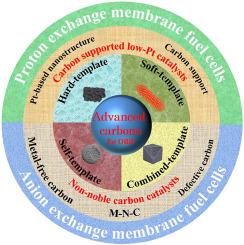Progress in Energy and Combustion Science ( IF 29.5 ) Pub Date : 2023-06-08 , DOI: 10.1016/j.pecs.2023.101101 Yizhe Chen , Shiming Zhang , Joey Chung-Yen Jung , Jiujun Zhang

|
Polymer electrolyte fuel cells, including acidic proton exchange membrane fuel cells (PEMFCs) and alkaline anion exchange membrane fuel cells (AEMFCs), are the types of the most promising high-efficiency techniques for conversion hydrogen energy to electricity energy. However, the catalysts’ insufficient activity and stability toward oxygen reduction reaction (ORR) at the cathodes of these devices are still the important constraints to their performance. So far, carbon black supported platinum (Pt/C) and its alloys are still the most practical and best-performing type of catalysts. However, the scarcity of Pt is highly challenging and the high price of commercial catalyst will continue to drive up the cost of both PEMFCs and AEMFCs. Moreover, the traditional carbon black support is susceptible to corrosion especially under electrochemical operation, itself inactive for ORR and weakly binding with Pt-based nanoparticles. In this review, the advanced carbons synthesized by various template methods, including hard-template, soft-template, self-template and combined-template, are systematically evaluated as low-Pt catalyst supports and non-noble catalysts. For the templates-induced carbon-based catalysts, this review presents a comprehensive overview on the carbon supported low-Pt catalysts from aspect of composition, size and shape control as well as the non-noble carbon catalysts such as transition metal-nitrogen-carbons, metal-free carbons and defective carbons. Furthermore, this review also summarizes the applications of low/non-Pt carbon-based catalysts base on the template-induce advanced carbons at the cathodes of PEMFCs and AEMFCs. Overall, the templates-induced carbons can show some perfect attributes including ordered morphology, reasonable pore structure, high conductivity and surface area, good corrosion resistance and mechanical property, as well as strong metal–support interaction. All of these features are of particular importance for the construction of high-performance carbon-based ORR catalysts. However, some drawbacks mainly involve the removal of templates, maintenance of morphological structure, and demetalation. To address these issues, this review also summarizes some effective strategies, such as employing the easily removed hard/soft-templates, developing the advantageous self-templates, enhancing the metal–support interaction by formation of chemical binds, etc. In conclusion, this review provides an effective guide for the construction of template-induced advanced carbons and carbon-based low/non-Pt catalysts with analysis of technical challenges in the development of ORR electrocatalysts for both PEMFCs and AEMFCs, and also proposes several future research directions for overcoming the challenges towards practical applications.
中文翻译:

碳作为低铂催化剂载体和用于聚合物电解质燃料电池的非贵金属催化剂
聚合物电解质燃料电池,包括酸性质子交换膜燃料电池(PEMFCs)和碱性阴离子交换膜燃料电池(AEMFCs),是最有前途的氢能转化为电能的高效技术类型。然而,催化剂对氧还原反应的活性和稳定性不足这些器件阴极的 (ORR) 仍然是其性能的重要制约因素。迄今为止,炭黑负载铂(Pt/C)及其合金仍然是最实用、性能最好的一类催化剂。然而,铂的稀缺性极具挑战性,商业催化剂的高价格将继续推高 PEMFC 和 AEMFC 的成本。此外,传统的炭黑载体易受腐蚀,尤其是在电化学操作下,本身对 ORR 不活跃,并且与 Pt 基纳米粒子的结合较弱. 在这篇综述中,通过各种模板法合成的高级碳,包括硬模板法、软模板法、自模板法和联合模板法,被系统地评估为低铂催化剂载体和非贵金属催化剂。对于模板诱导的碳基催化剂,这篇综述从组成、尺寸和形状控制方面全面概述了碳负载的低 Pt 催化剂以及过渡金属-氮-碳等非贵碳催化剂,无金属碳和有缺陷的碳。此外,这篇综述还总结了基于模板诱导高级碳的低/非 Pt 碳基催化剂在 PEMFC 和 AEMFC 阴极上的应用。总的来说,模板诱导的碳可以表现出一些完美的属性,包括有序的形态、合理的孔结构、良好的耐腐蚀性能和力学性能,以及强的金属-载体相互作用。所有这些特征对于构建高性能碳基 ORR 催化剂都特别重要。然而,一些缺点主要涉及模板的去除、形态结构的维持和脱金属。为了解决这些问题,这篇综述还总结了一些有效的策略,例如使用易于去除的硬/软模板、开发有利的自模板、通过形成化学键来增强金属-载体相互作用等。总之,这综述为构建模板诱导的高级碳和碳基低/无 Pt 催化剂提供了有效的指导,并分析了 ORR 开发中的技术挑战PEMFCs 和 AEMFCs 的电催化剂,并提出了几个未来的研究方向,以克服实际应用的挑战。



























 京公网安备 11010802027423号
京公网安备 11010802027423号